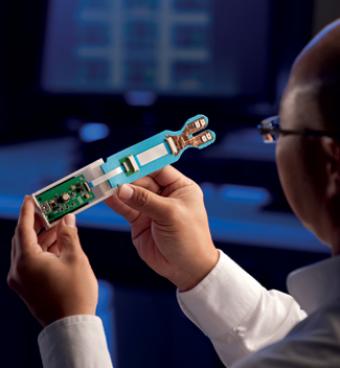The Sinus Illuminator
 It's a typically bustling day in the offices of Dr. Naveen Bhandarkar, director of rhinology and sinus surgery at UC Irvine Medical Center. There are sinuses to examine and infections to treat. But in a tiny office tucked into one corner of the clinic, innovation is taking shape as well.
It's a typically bustling day in the offices of Dr. Naveen Bhandarkar, director of rhinology and sinus surgery at UC Irvine Medical Center. There are sinuses to examine and infections to treat. But in a tiny office tucked into one corner of the clinic, innovation is taking shape as well.
Here, research assistant James Kim greets patients with symptoms of chronic sinusitis who agree to participate in a clinical study that could someday dramatically improve the way doctors diagnose the common but often bedeviling condition.
Kim instructs each patient to sit down and to open his or her mouth so he can insert a small probe that illuminates the sinuses. Pictures are snapped. It takes about as long as a driver's license photograph at the DMV – without the long lines.
And if it sounds simple, well, that's the whole point. The device, called a sinus illuminator, is being developed by Praxis BioSciences out of Calit2's TechPortal business incubator to advance the complex art of diagnosing sinusitis. The sinus illuminator shines near-infrared light into the four pairs of sinus cavities to produce images that could be used, some day, to screen for the disorder.
"We're trying to determine if the sinus is not healthy," says Bhandarkar. "The conflict doctors face is whether a patient has sinusitis or sinus thickening that correlates with the patient's current symptoms. Or do they have symptoms that might be secondary to allergies or other causes?"
That question perplexes physicians nearly every day. Sinusitis is one of the top 20 conditions seen in primary care settings. About 31 million adults are diagnosed with it each year, according to the U.S. Centers for Disease Control and Prevention; the condition is also common in children.
Sinusitis is defined as sinuses that are inflamed and is diagnosed as chronic after 12 weeks. But the symptoms – cough, facial pain, loss of smell, congestion, ear pressure, throat drainage – can be difficult to distinguish from allergies and other conditions.
Doctors suspecting sinusitis typically treat a patient with antibiotics. But if symptoms continue, the doctor may prescribe more antibiotics or order a computerized tomography scan to examine the sinuses. The downside of that approach is that antibiotics have side effects and CT scans are expensive, time-consuming and expose patients to radiation.
That's where the sinus illuminator comes in.
"We're asking: 'Is there a better way to get the diagnosis to guide treatment without the need for a CT?'" says Bhandarkar. "Questions are being asked a lot more about the risks associated with a CT scan and the costs. We may be able to avoid an immediate CT scan in some patients."
The sinus illuminator could emerge as that easy, quick, inexpensive way to give doctors more information upon which to base treatments and order additional tests. The idea for the device was developed more than a decade ago by Dr. Brian Wong, a professor of otolaryngology-head and neck surgery, biomedical engineering and surgery at UC Irvine, who founded Praxis BioSciences with biomedical engineer Joon You.
"It was a long time brewing," says Wong, who is not involved in the clinical studies. "What has changed is the reduction in cost that was needed to use infrared light."
The device, about the size of a matchbox, contains an array of tiny LED lights. By using near-infrared light, most of the tissues in the sinus area become transparent. For example, healthy sinuses show up as brightly lit regions that represent the pockets of air. But in a patient with sinusitis, the anatomy appears much different due to swollen tissue and mucus.
"Every doctor uses light in one way or another," says Albert Cerussi, an optics expert at the Beckman Laser Institute and Medical Clinic and a collaborator on the project. "With the doctor's eyes, however well-trained, they are only looking at the surface of the tissue. Near-infrared allows you to see deeper below the surface more efficiently. That is where the novelty is."
Near-infrared technology became more affordable and accessible for biotechnology uses about a decade ago, says You, Praxis’ chief technology officer. Prior to that time, it was mostly confined to military gadgets. Near-infrared has wavelengths that are longer than those of visible light.
The ongoing study in Bhandarkar's office will involve 50 to 100 people. The inventors hope to develop precise algorithms to help doctors analyze the images.
The sinus illuminator "is off-the-shelf technology," You explains. "We basically designed it in a way that it would be very simple to use and fast. We don't want the operator to sit there and play around with the settings or calibrate it or anything that takes time away from their main duties."
The device is not intended as the sole means to diagnose sinusitis but as an extra tool, he says. Should the device reach the marketplace as hoped, it would represent the kind of evidence-based, cost-effective medical test that the government, health insurers and consumers are clamoring for. Moreover, You and his co-inventors are also working on technology that would transmit the images by Wi-Fi to a database or doctor's tablet.
"This is winning technology," says Wong, whose company already has several products on the market, including the EarTrumpet, an iPhone-based hearing test and sound-amplification system. "You have to match the technology with the application. This is near optimal."
-- Shari Roan
